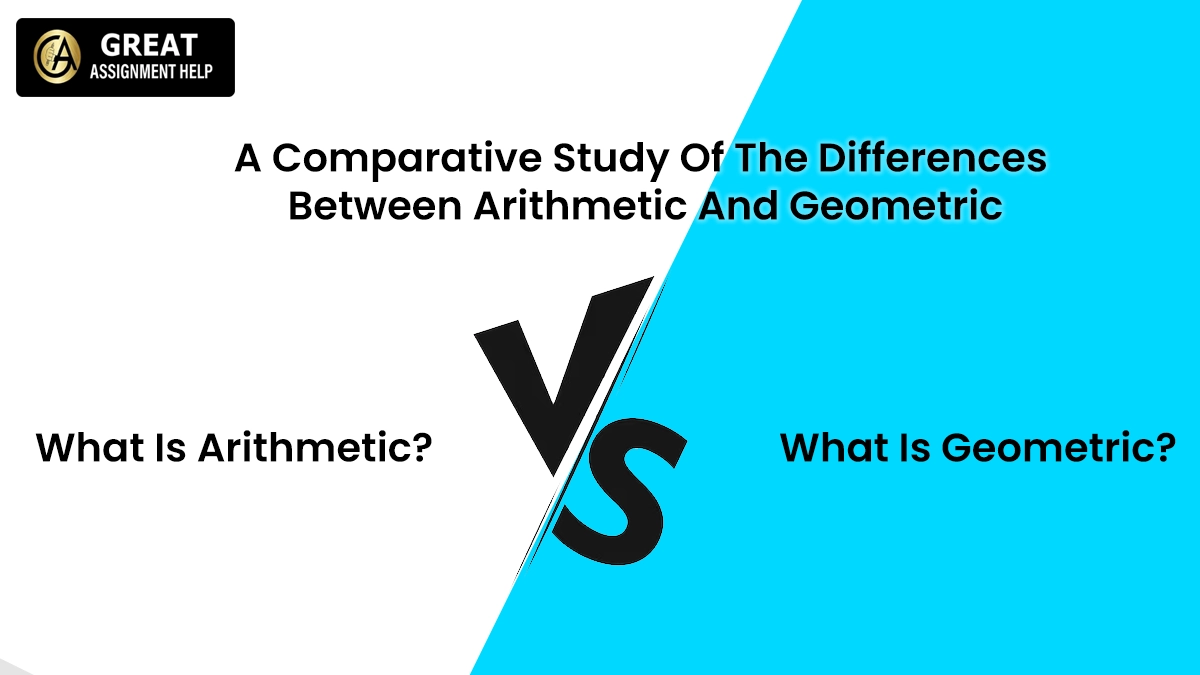Arithmetic and Geometry are some of the few branches of mathematics that students get acquainted with quite early in their academic careers. They both are essential to developing problem-solving skills in students. However, they both have multiple differences. For example, arithmetic is used in the everyday calculations of every common man on earth from paying bills to buying groceries. In contrast, geometric has specialized uses. From the time of its introduction, it is mainly used in astronomy. Apart from that, it is also required for building constructions and computer graphics. If you are intrigued to learn about the difference between arithmetic vs. geometric, read this blog. Here, we have conducted a comprehensive study of the disparities.
A Comparative Study Of The Differences Between Arithmetic And Geometric
Here is a comprehensive study of the differences between arithmetic and geometric.
Arithmetic vs. Geometric: Concepts
The geometric concept and arithmetic concepts are quite different. Here is the difference between the concepts of the two branches of mathematics.
- What Is Arithmetic?
Arithmetic is the fundamental branch of mathematics that deals with the study of features and traditional functions of numbers like addition, subtraction, multiplications, subtraction, exponentiation, and extraction of roots. Advanced arithmetic subjects like algebra, trigonometry, and calculus are based on arithmetic. Moreover, it is an indispensable part of various professions including finance, engineering, and scientific research.
Rea more: Arithmetic vs. Mathematics: An Analysis of the Differences
- What Is Geometric?
Geometric is the term used to denote the subject’s geometry. Geometry was introduced by the Greeks. It refers to the branch of mathematics that deals with properties of space, like distance, shape, size, and relative position of figures. It studies various figures, like points, lines, angles, triangles, circles, squares, and shapes, such as polygons, octagons, hexagons, and polyhedral. Features and principles of geometry are employed to measure, compare, and analyze objects, as well as to solve problems and create new designs. It is an indispensable part of art, fashion, and decor and is widely used to create visual designs.
Arithmetic Vs. Geometric: Real-Life Uses
In practical life, arithmetic principles and geometric principles have different uses. Take a look at their difference:
- Arithmetic
Following are the practical-life uses of arithmetic:
- Managing Time
People must manage time to perform multiple tasks in a day and make the day purposeful. Knowledge of arithmetic helps to set a justifiable deadline and complete tasks within the given time. Moreover, it is also essential for creating day-to-day timetables. These tasks help to manage time wisely
- Budgeting
Everybody leads their life with a limited amount of money. However, a budget is required to keep the expenses in check and save for the future. Arithmetic operations help to calculate the expenses in sectors of life and make savings.
- Exercising
Workout becomes effective when one meets their daily count of a specific exercise. Counting is an operation of arithmetic. Thus, arithmetic helps to stay fit.
- Driving
Driving a car or bike is all about a sequence of calculations required for reaching the destinations. Commonly, driving a car incorporates kilometers that help travel quickly and find the best route to get to the destination.
- Home Decorating
Wallpaper is an essential element of home decoration. Every house or room comes in different sizes. However, most wallpaper is available in measures of meters and square meters. Calculating the perimeter of a wall and then converting it into square meters is essential to buy and use the required quantity of wallpapers.
- Stitching and crocheting
Arithmetic is one of the essential components of couture. Calculating the number of stitches or crochets required or made in a piece helps to make every similar item flawless. Additionally, it requires measurements of the person for whom a dress is designed and estimating the cost and profit, and length of cloth needed to develop the piece. These things can only be performed by utilizing arithmetic operations.
- Critical Thinking
Arithmetic also enhances the ability to think critically, like solving puzzles, analyzing, etc.
- Geometric
Rea more: Best Math Research Topics for Students to Consider
Here are some practical-life uses of geometric:
- Construction Of Buildings
Geometry plays an essential role in the construction of buildings. It is used to create dams, buildings, rivers, temples, etc.
- Computer Graphics
Computer graphics also take the help of geometry. Furthermore, geometry also helps in creating infotainment or entertainment audio-visual presentations. Apart from that, it also helps in determining the connection of distance with the shape of the object. Moreover, the concepts of geometry play a crucial role in designing smartphones, laptops, computers, etc.
- Sports
Without the knowledge of math, it is impossible to keep track of scores for sports activities. Geometry and trigonometry help enhance their skills in sports. In short, geometric calculations help to decide the best way to strike the ball or reach a basket.
- Art
Geometry also helps artists. Drawing angles, measuring proportions, and getting perspectives about an artwork becomes easy through geometry.
- Measuring Orbits And Planetary Motions
Astronomers employ geometric calculations and concepts to track the movement of stars and compute the orbits and the space between planets and satellites.
Arithmetic Vs. Geometric: History
Arithmetic concepts and uses did not start at the time of the introduction of geometric uses and concepts. Following is the difference in their history.
- Arithmetic: It is believed that arithmetic principles were introduced 10,000 years ago in prehistoric times when people started farming.
- Geometry: Geometry was introduced in 3000 BC. Euclid, the father of geometry developed it first in Greece.
Arithmetic vs. Geometric: Benefits
The benefits you draw from arithmetic is different from the one you gain from geometric. The following are the differences:
- Arithmetic
The pros of arithmetic are as follows:
- Easy to calculate
- Follows fixed patterns
- Easy to understand
- Geometric
The perks of geometric are as below:
- Rigidly defined and follows the patterns
- Understanding geometric sequences can help in using algebraic equations accurately.
Arithmetic vs. Geometric: Drawbacks
There are many drawbacks to both arithmetic and geometry. However, the drawbacks of arithmetic are contrasting with that of geometric. The following are the differences:
- Arithmetic
Here are the drawbacks of arithmetic
- Precise averages of ratios and percentages can never be derived.
- Finding averages of highly skilled data is impossible
- Geometric
Here are the disadvantages of geometric:
- Difficult to compute
- Understanding geometric patterns can at times be difficult.
Arithmetic Vs. Geometric: Sequencing Examples
Here are the differences between arithmetic and geometric in terms of sequencing examples:
- Arithmetic
Here are some examples of arithmetic sequencing:
- Following is the arithmetic sequence with a difference in the successive terms:1, 4, 7, 10, 13, 16
- The arithmetic sequence of the following numbers is with a difference of 5 numbers: 28, 23, 18, 13, 8
- Geometric
Find the samples of geometric sequencing here:
- In the following sequence of numbers of the geometric sequence, each successive term is three times a multiple of the previous number: 2, 6, 18, 54, and 162.
- The following geometric sequence of numbers includes a successive term that is one-fourth the value of the previous number: 64, 16, 4, and 1.
Arithmetic Vs. Geometric: Methods Of Obtaining Successive Term
Here is the difference in the way successive terms are obtained in arithmetic and geometry:
- Arithmetic: It uses addition and subtraction to obtain successive terms.
- Geometric: It uses multiplication and division to get the successive terms.
Arithmetic vs. Geometric: Nature of sequence
Arithmetic and geometric has different nature of sequencing numbers. The differences are as follows:
- Arithmetic: Arithmetic sequences are divergent
- Geometric: Geometric sequences can be convergent or divergent
Arithmetic Vs. Geometric: Features Of Successive Terms
The results of the successive terms of arithmetic and geometric are different. The following are the differences:
- Arithmetic: The successive terms highlight a common difference.
- Geometric: The successive terms showcase a common ratio.
Arithmetic vs. Geometric: Variation
Different variations can be observed in the case of arithmetic and geometric terms.
- Arithmetic: It shows linear variation.
- Geometric: It shows the exponential variation
Also read: What Is A Term In Math, And How To Solve A Mathematical Term?
A Tabular Representation Of The Differences Between Arithmetic And Geometric
| Parameter | Arithmetic | Geometric |
| Definition | It deals with the features and traditional functions like addition, subtraction, multiplication, and division. | It is concerned with properties of space, like distance, shape, size, and relative position of figures. |
| Real-life uses | Common uses of arithmetic are as follows:
· Managing Time · Budgeting · Exercising · Driving · Home Decorating · Stitching and crocheting · Critical Thinking |
Typical uses of geometric are:
· Construction Of Buildings · Computer Graphics · Sports · Art · Measuring Orbits And Planetary Motions |
| History | Human began using arithmetic 10, 000 years ago in prehistoric times when they started farming.
|
Euclid developed Geometric in 3000 BC. |
| Benefits | The perks of arithmetic are as follows:
· effortless to compute · sticks to fixed patterns · simple to understand |
Following are the benefits of geometry:
· strictly defined and sticks to the patterns · Learning geometric sequences can help in accurate use of algebraic equations. |
| Drawbacks | Here are the disadvantages of arithmetic
· It is impossible to derive accurate mean of ratios and percentages. · Without the knowledge of arithmetic one can never find the averages of highly skilled data. |
Following are the drawbacks of geometric:
· Not easy to compute · Comprehending geometric patterns can at times be difficult. |
| Methods of obtaining successive term | Each successive term is derived through addition or subtraction | Each successive term is derived through multiplication or division |
| Nature of sequence | The successive terms have a divergent nature. | The successive terms have both divergent and convergent nature |
| Features of successive terms | They indicate a common difference | They indicate a common ratio |
| Variation | It indicates linear variation | It indicates exponential variation |
Conclusion
The discussion above highlights the difference between arithmetic vs. geometric. It is important to have a clear idea of the two branches of mathematics. Arithmetic is the foundation of mathematics. It deals with numbers and the operations of numbers like addition, subtraction, multiplications, and division. In contrast, geometry is concerned with the measurement, properties, and relationships of points, lines, angles, surfaces, and solids. Moreover, knowledge of these differences helps you to gain interest in math and reduces the fear towards the subject.



